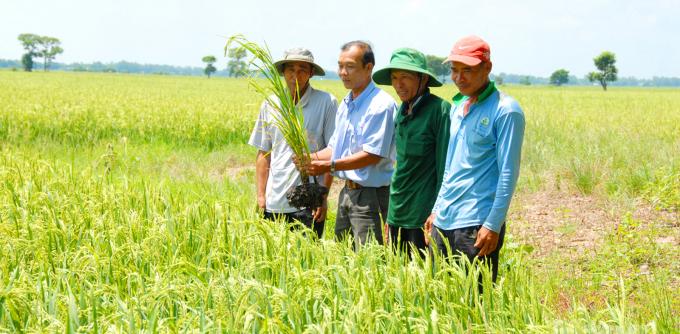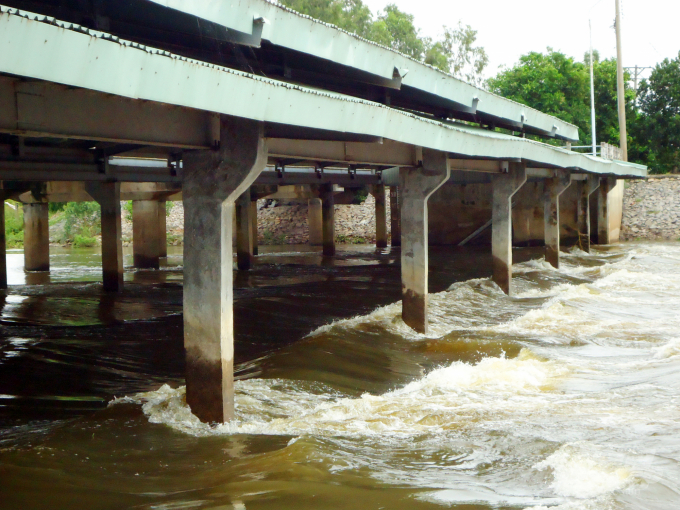November 27, 2025 | 22:24 GMT +7
November 27, 2025 | 22:24 GMT +7
Hotline: 0913.378.918
November 27, 2025 | 22:24 GMT +7
Hotline: 0913.378.918
An Giang is the top upstream province, with 643 subregions and a total of 254,210 hectares of rice cropland protected from flooding during the rainy season. 421 subregions in the province constructed dykes to effectively manage flooding, guaranteeing safe production.

An Giang recommends farmers apply integrated solutions to save costs for growing rice. Photo: Le Hoang Vu.
In the areas encompassed by dykes, the cultivation of three harvests of rice each year has supported in the creation of employment and increased revenue for farmers in recent years. However, this condition is extended and exploited, compressing the soil's nutrients to the point of exhaustion. As a consequence, farmers have been forced to apply more fertilizers and pesticides in recent years, yet rice yields have continued to decline.
Nguyen Huu Thien, an independent researcher specializing in Mekong Delta ecology, said that the Mekong Delta has been impacted by climate change in the past, impacting agricultural output, particularly rice. Inefficient rice production is also caused by nutrient deficiency in the soil, which is insufficient to provide crops, a tillage regime, and continuous rice production.

Organic rice production, associated with integrated pest management is one of the sustainable solutions that An Giang is currently developing. Photo: Le Hoang Vu.
Deep plowing and solarization after each harvest have become uncommon in the Mekong Delta during the last decade. Rather than taking time to isolate and solarize the field to rest it, farmers let the ground grow rice constantly. The prolonged wet situation between crops makes it difficult for the soil to absorb nutrients, which readily results in fertilizer loss and easy-fall of rice, decreasing production.
Additionally, one of the primary causes for the deficiency of nutrients in rice land is the low flood level, which results in a decrease in the quantity of alluvium, which is critical for rice cultivation and agricultural output.
According to Nguyen Si Lam, Director of the An Giang Department of Agriculture and Rural Development, the province produces three rice harvests each year over an area of more than 670,000 hectares. Recently, the province has encouraged farmers to focus on safe, clean, and organic agriculture to satisfy market demand.

Soil becomes poor in nutrients due to continuous rice production which is one of the reasons for inefficient rice production. Photo: Le Hoang Vu.
Additionally, the agricultural sector recommends numerous ways for rice farmers to save money and increase profits, including the use of IPM programs such as "3 decreases 3 increase" and "1 must 5 decreases," as well as ecological technology, to reduce excessive urea chemical fertilizer use and to balance organic and NPK synthetic fertilizers, with an emphasis on the basal fertilizing phase. Additionally, using alluvium from the Mekong River is an efficient method to supplement the rice soil with nutrients, wash away pollutants in the field, and balance beneficial bacteria in the soil.
Additionally, using straw to restore nutrients to the soil is a beneficial option that contributes to the soil being more fruitful.
Organic rice cultivation, according to Lam, is also one of the current sustainable alternatives. In An Giang province, several farmers in An Phu district have successfully implemented a biosafety rice production plan without using pesticides.

The increase in flood discharge to collect alluvium and the use of organic fertilizers will help plants grow sustainably. Photo: Le Hoang Vu.
For many years, the approach has been successful because it not only assists farmers in reducing their reliance on chemical fertilizers and pesticides but also restores land resources to their natural fertility. Especially in the summer-autumn harvest of 2021, An Giang and Loc Troi Group pioneered rice spread, enabling farmers to save 15% on input prices, and Loc Troi's production remained extremely steady throughout the crop. An Giang is anticipated to increase the area under this strategy to about 100,000 hectares in the next rice harvests.
Tran Anh Thu, Vice Chairman of the An Giang Provincial People's Committee, said that An Giang would decrease its rice-producing area in the near future. Rather than that, An Giang's agriculture sector has solutions to assist farmers in transforming crop and livestock models that are suited to the region's features and have a high economic value in order to serve the market. This is one of the province's long-term options for developing sustainable agriculture.
Translated by Linh Linh
/2025/11/27/3830-1-152901_403.jpg)
(VAN) Dong Nai is developing its key crop areas, expanding planting area codes, and applying high technology to increase the value of agricultural products, aiming at a green and sustainable agriculture.

(VAN) Tay Ninh’s livestock sector is undergoing a major transformation, applying high-tech, closed-loop circular models to build sustainable value chains.
/2025/11/26/3627-4-082628_818.jpg)
(VAN) From a small café on the red basalt highlands, Le Van Hoang started a business with clean coffee, building Enjoi Coffee into a symbol of organic agriculture in the Lam Dong plateau.
/2025/11/25/0045-1-135246_13.jpg)
(VAN) Ca Mau is researching a model of sea-encroaching embankments combined with viaducts and logistics service zones, aiming both to prevent erosion and create land funds for marine economic development.

(VAN) The information was shared at the seminar 'Urban Agriculture - Solutions for Developing Green Spaces,' organized by the Kinh te & Do thi Newspaper and the Biotechnology Center of Ho Chi Minh City.
/2025/11/19/4141-2-132831_216.jpg)
(VAN) One of Japfa's outstanding solutions is implementing digital transformation and artificial intelligence (AI) to optimize operations, enhance productivity, and advance sustainable development.
/2025/11/19/4847-1-093540_448.jpg)
(VAN) The Gia Lai Provincial People’s Committee had a working session with the delegation of the U.S. Department of Agriculture, the State of Idaho, and representatives of the State's leading enterprises.